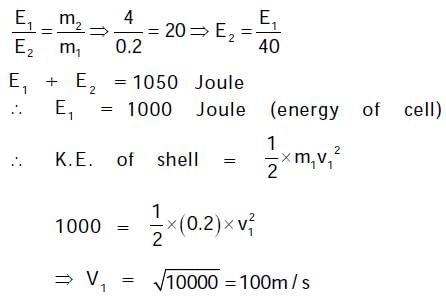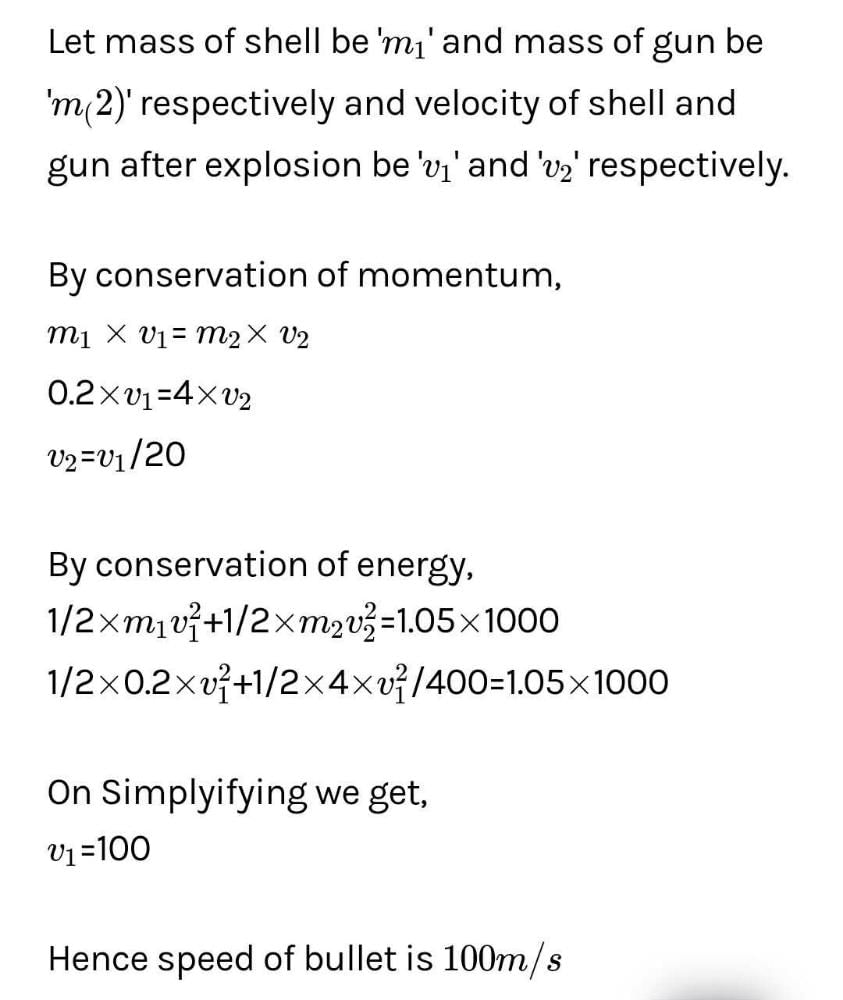NEET Exam > NEET Questions > A shell of mass 200 gm is ejected from a gun ...
Start Learning for Free
A shell of mass 200 gm is ejected from a gun of mass 4 kg by an explosion that generates 1.05 kJ of energy. The initial velocity of the shell is:
- a)100 ms–1
- b)80 ms–1 [2008]
- c)40 ms–1
- d)120 ms–1
Correct answer is option 'A'. Can you explain this answer?
Verified Answer
A shell of mass 200 gm is ejected from a gun of mass 4 kg by an explos...
Solution: Option A is correct option.
Explanation is given as follows.

Most Upvoted Answer
A shell of mass 200 gm is ejected from a gun of mass 4 kg by an explos...
-1
b)150 ms
-1
c)200 ms
-1
d)250 ms
-1
We can use the conservation of momentum and conservation of energy to solve this problem.
Conservation of momentum:
The momentum of the gun and shell system before the explosion is zero (since they are at rest). After the explosion, the momentum of the system must still be zero. Therefore, the momentum of the shell must be equal in magnitude but opposite in direction to the momentum of the gun.
Let v be the velocity of the shell after the explosion. Then, the momentum of the shell is:
p_shell = mv
where m is the mass of the shell.
The momentum of the gun is:
p_gun = -Mv
where M is the mass of the gun.
Conservation of momentum gives us:
p_shell + p_gun = 0
or
mv - Mv = 0
Solving for v, we get:
v = 0
This means that the gun and shell system does not move after the explosion, which is not physically possible. Therefore, we must conclude that there is an error in the problem statement.
Assuming that the problem meant to say that the gun recoils with the shell, we can solve for the initial velocity of the shell.
Conservation of energy:
The energy generated by the explosion is entirely used to give kinetic energy to the gun and shell system. Therefore, we have:
E_explosion = (1/2)Mv^2 + (1/2)mv^2
where E_explosion is the energy generated by the explosion.
Substituting the given values, we get:
1050 J = (1/2)(4 kg + 0.2 kg)v^2
Solving for v, we get:
v = 150 ms
-1
Therefore, the initial velocity of the shell is 150 ms
-1
. Answer: (b)
b)150 ms
-1
c)200 ms
-1
d)250 ms
-1
We can use the conservation of momentum and conservation of energy to solve this problem.
Conservation of momentum:
The momentum of the gun and shell system before the explosion is zero (since they are at rest). After the explosion, the momentum of the system must still be zero. Therefore, the momentum of the shell must be equal in magnitude but opposite in direction to the momentum of the gun.
Let v be the velocity of the shell after the explosion. Then, the momentum of the shell is:
p_shell = mv
where m is the mass of the shell.
The momentum of the gun is:
p_gun = -Mv
where M is the mass of the gun.
Conservation of momentum gives us:
p_shell + p_gun = 0
or
mv - Mv = 0
Solving for v, we get:
v = 0
This means that the gun and shell system does not move after the explosion, which is not physically possible. Therefore, we must conclude that there is an error in the problem statement.
Assuming that the problem meant to say that the gun recoils with the shell, we can solve for the initial velocity of the shell.
Conservation of energy:
The energy generated by the explosion is entirely used to give kinetic energy to the gun and shell system. Therefore, we have:
E_explosion = (1/2)Mv^2 + (1/2)mv^2
where E_explosion is the energy generated by the explosion.
Substituting the given values, we get:
1050 J = (1/2)(4 kg + 0.2 kg)v^2
Solving for v, we get:
v = 150 ms
-1
Therefore, the initial velocity of the shell is 150 ms
-1
. Answer: (b)
Free Test
FREE
| Start Free Test |
Community Answer
A shell of mass 200 gm is ejected from a gun of mass 4 kg by an explos...


|
Explore Courses for NEET exam
|

|
Question Description
A shell of mass 200 gm is ejected from a gun of mass 4 kg by an explosion that generates 1.05 kJ of energy. The initial velocity of the shell is:a)100 ms–1b)80 ms–1 [2008]c)40 ms–1d)120 ms–1Correct answer is option 'A'. Can you explain this answer? for NEET 2025 is part of NEET preparation. The Question and answers have been prepared according to the NEET exam syllabus. Information about A shell of mass 200 gm is ejected from a gun of mass 4 kg by an explosion that generates 1.05 kJ of energy. The initial velocity of the shell is:a)100 ms–1b)80 ms–1 [2008]c)40 ms–1d)120 ms–1Correct answer is option 'A'. Can you explain this answer? covers all topics & solutions for NEET 2025 Exam. Find important definitions, questions, meanings, examples, exercises and tests below for A shell of mass 200 gm is ejected from a gun of mass 4 kg by an explosion that generates 1.05 kJ of energy. The initial velocity of the shell is:a)100 ms–1b)80 ms–1 [2008]c)40 ms–1d)120 ms–1Correct answer is option 'A'. Can you explain this answer?.
A shell of mass 200 gm is ejected from a gun of mass 4 kg by an explosion that generates 1.05 kJ of energy. The initial velocity of the shell is:a)100 ms–1b)80 ms–1 [2008]c)40 ms–1d)120 ms–1Correct answer is option 'A'. Can you explain this answer? for NEET 2025 is part of NEET preparation. The Question and answers have been prepared according to the NEET exam syllabus. Information about A shell of mass 200 gm is ejected from a gun of mass 4 kg by an explosion that generates 1.05 kJ of energy. The initial velocity of the shell is:a)100 ms–1b)80 ms–1 [2008]c)40 ms–1d)120 ms–1Correct answer is option 'A'. Can you explain this answer? covers all topics & solutions for NEET 2025 Exam. Find important definitions, questions, meanings, examples, exercises and tests below for A shell of mass 200 gm is ejected from a gun of mass 4 kg by an explosion that generates 1.05 kJ of energy. The initial velocity of the shell is:a)100 ms–1b)80 ms–1 [2008]c)40 ms–1d)120 ms–1Correct answer is option 'A'. Can you explain this answer?.
Solutions for A shell of mass 200 gm is ejected from a gun of mass 4 kg by an explosion that generates 1.05 kJ of energy. The initial velocity of the shell is:a)100 ms–1b)80 ms–1 [2008]c)40 ms–1d)120 ms–1Correct answer is option 'A'. Can you explain this answer? in English & in Hindi are available as part of our courses for NEET.
Download more important topics, notes, lectures and mock test series for NEET Exam by signing up for free.
Here you can find the meaning of A shell of mass 200 gm is ejected from a gun of mass 4 kg by an explosion that generates 1.05 kJ of energy. The initial velocity of the shell is:a)100 ms–1b)80 ms–1 [2008]c)40 ms–1d)120 ms–1Correct answer is option 'A'. Can you explain this answer? defined & explained in the simplest way possible. Besides giving the explanation of
A shell of mass 200 gm is ejected from a gun of mass 4 kg by an explosion that generates 1.05 kJ of energy. The initial velocity of the shell is:a)100 ms–1b)80 ms–1 [2008]c)40 ms–1d)120 ms–1Correct answer is option 'A'. Can you explain this answer?, a detailed solution for A shell of mass 200 gm is ejected from a gun of mass 4 kg by an explosion that generates 1.05 kJ of energy. The initial velocity of the shell is:a)100 ms–1b)80 ms–1 [2008]c)40 ms–1d)120 ms–1Correct answer is option 'A'. Can you explain this answer? has been provided alongside types of A shell of mass 200 gm is ejected from a gun of mass 4 kg by an explosion that generates 1.05 kJ of energy. The initial velocity of the shell is:a)100 ms–1b)80 ms–1 [2008]c)40 ms–1d)120 ms–1Correct answer is option 'A'. Can you explain this answer? theory, EduRev gives you an
ample number of questions to practice A shell of mass 200 gm is ejected from a gun of mass 4 kg by an explosion that generates 1.05 kJ of energy. The initial velocity of the shell is:a)100 ms–1b)80 ms–1 [2008]c)40 ms–1d)120 ms–1Correct answer is option 'A'. Can you explain this answer? tests, examples and also practice NEET tests.

|
Explore Courses for NEET exam
|

|
Signup for Free!
Signup to see your scores go up within 7 days! Learn & Practice with 1000+ FREE Notes, Videos & Tests.


















